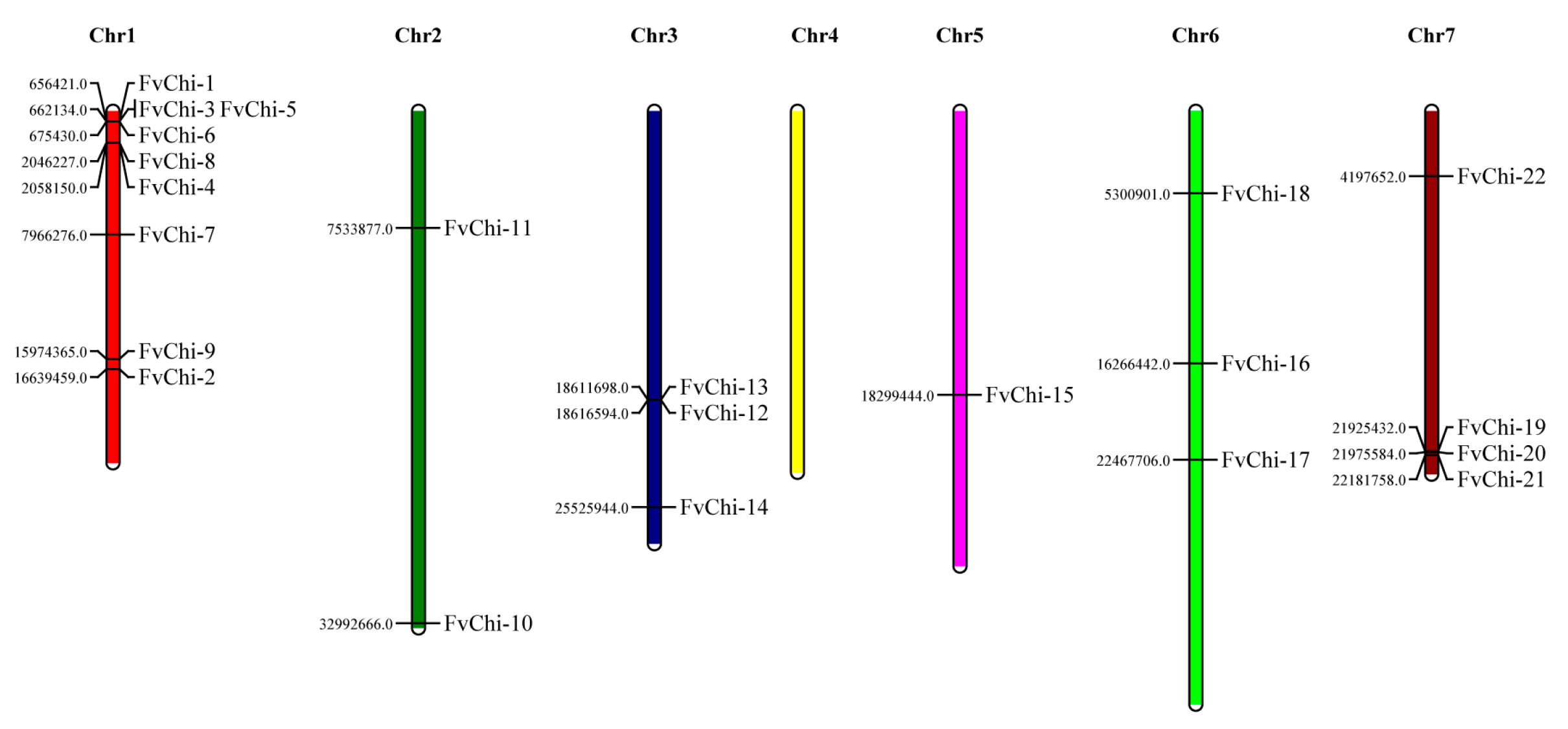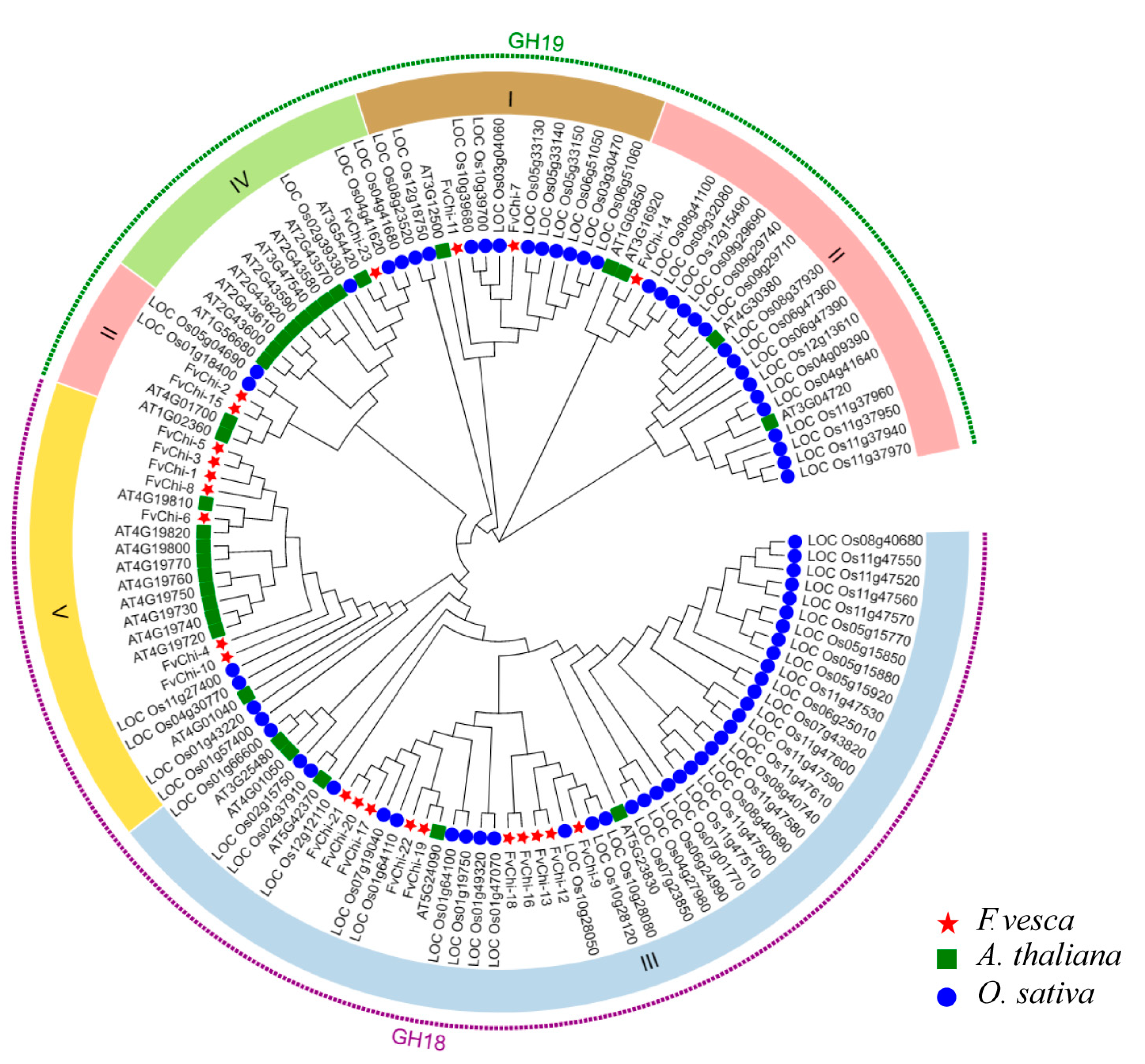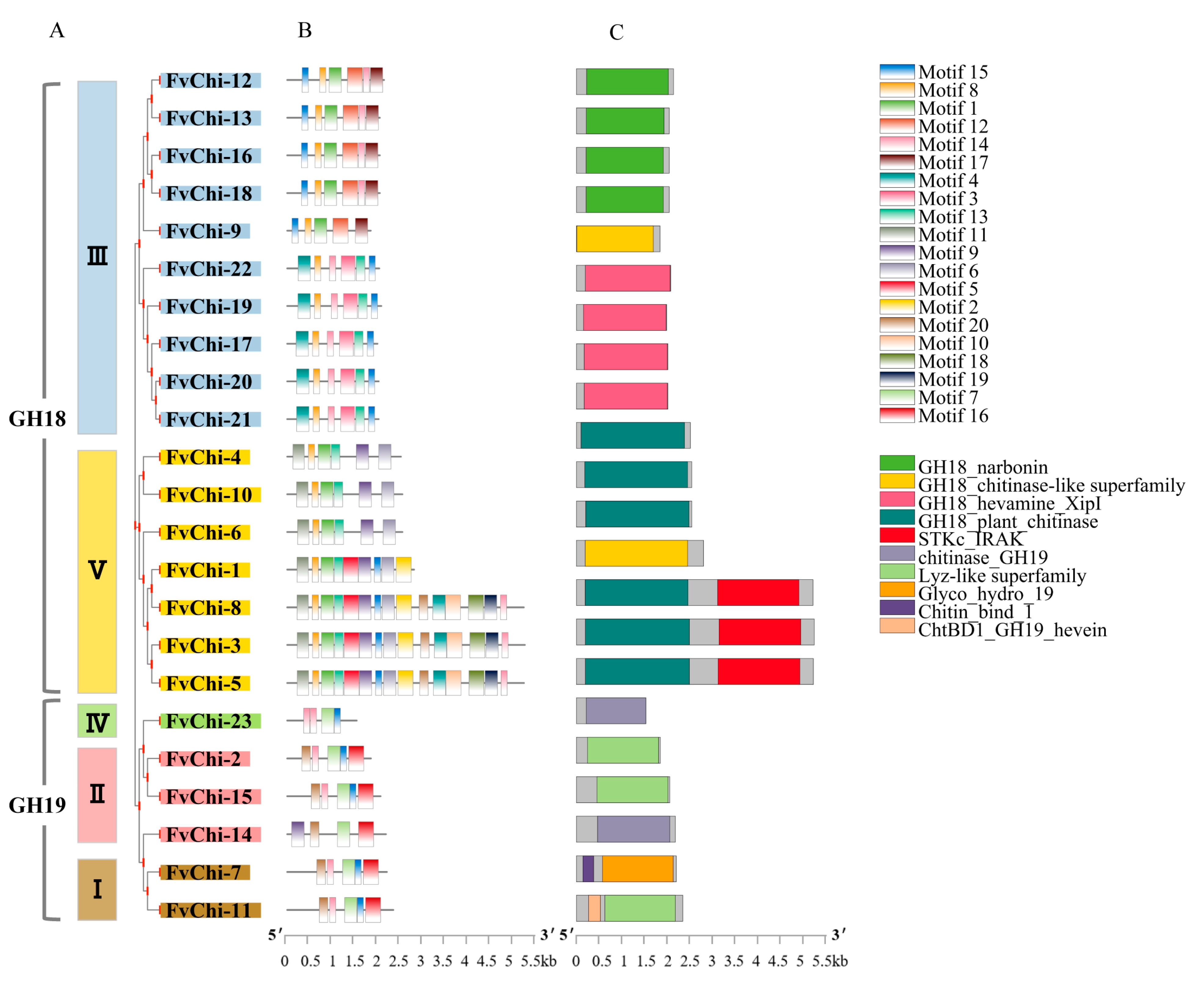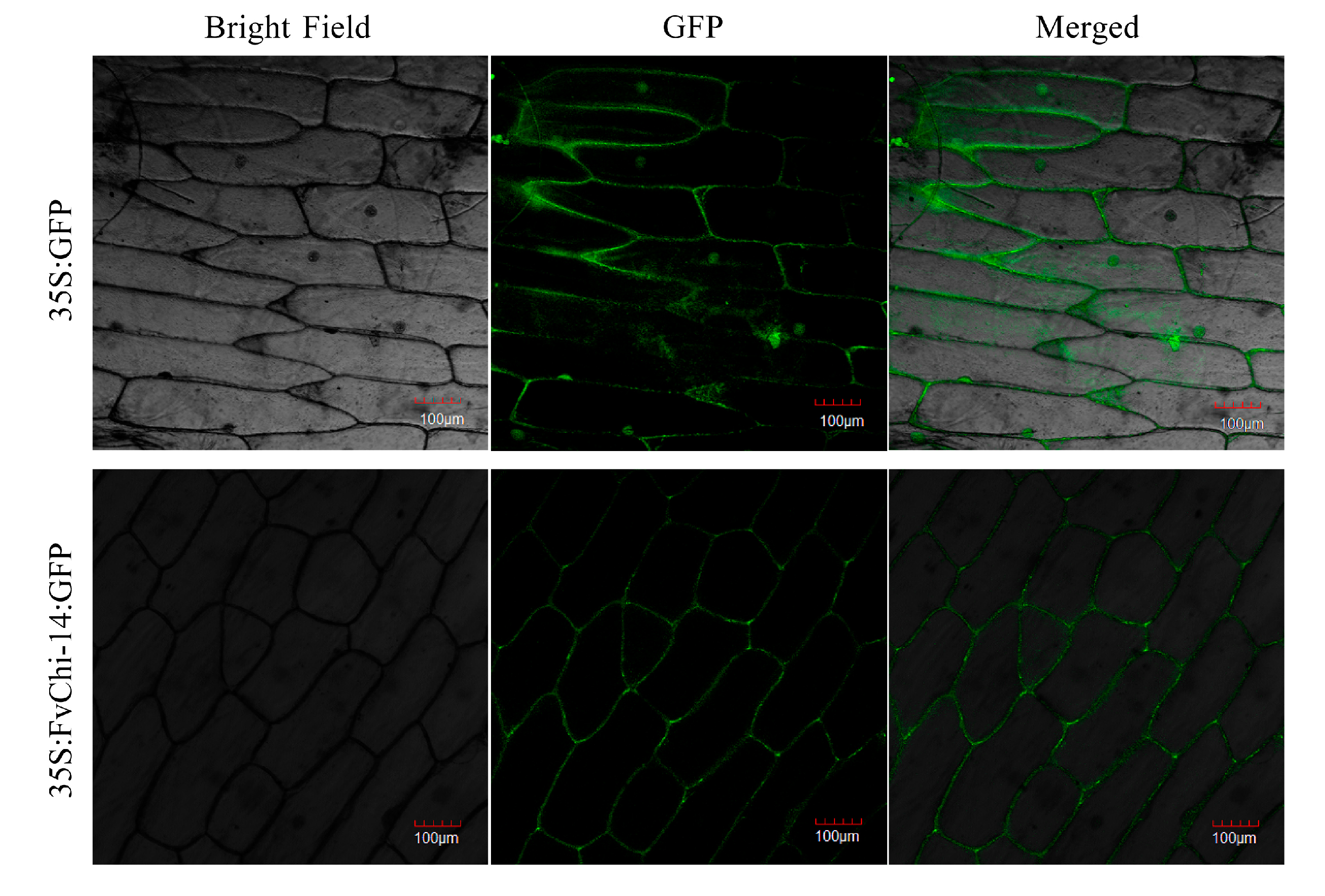Bioinformatics and Expression Analysis of the Chitinase Genes in Strawberry (Fragaria vesca) and Functional Study of FvChi-14
Abstract
1. Introduction
2. Results
2.1. Identification and Physiochemical Properties of FvChi Proteins
2.2. Phylogenetic Studies of FvChi Genes
2.3. Gene Structure Architecture of FvChi Genes and Expansion Patterns
2.4. Analysis of Cis-Acting Elements in FvChi Gene Promoters
2.5. Expression Analysis of FvChi Gene in Tissue/Organs
2.6. Expression Analysis of FvChi Genes Following C. gloeosporioides Inoculation
2.7. Expression Analysis of Selected FvChi Genes Following SA and MeJA Treatments
2.8. FvChi14 Overexpression in A. thaliana Enhances Resistance to C. higginsianum
2.9. Subcellular Localization of FvChi-14 in Onion Cells
2.10. Prokaryotic Expression and Western Blot Analysis of FvChi-14
3. Discussion
4. Materials and Methods
4.1. Plant Materials and Seedlings Treatment
4.2. Identification of Chitinase Genes in Strawberry
4.3. Characterization Analysis of Strawberry Chitinase Genes
4.4. Gene Structure and Motif Distribution Patterns Analysis
4.5. Phylogenetic Studies of FvChi Genes
4.6. Expansion Pattern and Promoter Analysis of FvChi Genes
4.7. Expression Analysis of FvChi Genes
4.8. Plasmid Construction and A. thaliana Transformation
4.9. Subcellular Localization of FvChi-14 in Onion Cells
4.10. Prokaryotic Expression and Western Blot Analysis of FvChi-14
5. Conclusions
Supplementary Materials
Author Contributions
Funding
Data Availability Statement
Acknowledgments
Conflicts of Interest
References
- Wen, X.; Tengsheng, Z.; Dandan, L.; Sufang, A.; Jinna, H.; Genyi, L. Evolution and Expression Divergence of the Chitinase Gene Family against Leptosphaeria maculans and Sclerotinia sclerotiorum Infection in Brassica napus. J. Henan Agric. Sci. 2020, 49, 89–103. [Google Scholar] [CrossRef]
- Lv, P.; Zhang, C.; Xie, P.; Yang, X.; El-Sheikh, M.A.; Hefft, D.I.; Ahmad, P.; Zhao, T.; Bhat, J.A. Genome-Wide Identification and Expression Analyses of the Chitinase Gene Family in Response to White Mold and Drought Stress in Soybean (Glycine max). Life 2022, 12, 1340. [Google Scholar] [CrossRef] [PubMed]
- Liu, Z.; Yu, W.; Cai, W.; Liu, Z.; Zang, Y.; Yuan, Y.; Wu, B.; Lv, M. Genome-wide Identification and Expression Analysis of CTL Gene Family Memebers in Capsicum annuum L. Chin. J. Trop. Crops 2021, 42, 3101–3110. [Google Scholar]
- Tobias, P.A.; Christie, N.; Naidoo, S.; Guest, D.I.; Kulheim, C. Identification of the Eucalyptus grandis chitinase gene family and expression characterization under different biotic stress challenges. Tree Physiol. 2017, 37, 565–582. [Google Scholar] [CrossRef]
- Bordoloi, K.S.; Krishnatreya, D.B.; Baruah, P.M.; Borah, A.K.; Mondal, T.K.; Agarwala, N. Genome-wide identification and expression profiling of chitinase genes in tea (Camellia sinensis (L.) O. Kuntze) under biotic stress conditions. Physiol. Mol. Biol. Plants 2021, 27, 369–385. [Google Scholar] [CrossRef]
- Chandra, S.; Dutta, A.K.; Chandrashekara, K.N.; Acharya, K. In silico characterization, homology modeling of Ca-mellia sinensis chitinase and its evolutionary analyses with other plant chitinases. Proc. Natl. Acad. Sci. India Sect. B Biol. Sci. 2015, 87, 685–695. [Google Scholar] [CrossRef]
- Passarinho, P.A.; de Vries, S.C. Arabidopsis Chitinases: A Genomic Survey. Arab. Book 2002, 1, e0023. [Google Scholar] [CrossRef]
- Cletus, J.; Balasubramanian, V.; Vashisht, D.; Sakthivel, N. Transgenic expression of plant chitinases to enhance disease resistance. Biotechnol. Lett. 2013, 35, 1719–1732. [Google Scholar] [CrossRef]
- Xin, Y.; Wang, D.; Han, S.; Li, S.; Gong, N.; Fan, Y.; Ji, X. Characterization of the Chitinase Gene Family in Mulberry (Morus notabilis) and MnChi18 Involved in Resistance to Botrytis cinerea. Genes 2021, 13, 98. [Google Scholar] [CrossRef]
- Ali, M.; Li, Q.-H.; Zou, T.; Wei, A.-M.; Gombojab, G.; Lu, G.; Gong, Z.-H. Chitinase Gene Positively Regulates Hypersensitive and Defense Responses of Pepper to Colletotrichum acutatum Infection. Int. J. Mol. Sci. 2020, 21, 6624. [Google Scholar] [CrossRef]
- Jingjing, L.; Renying, Z.; Xiaohua, Q.; Qiang, X.; Xuehao, C. A Preliminary Study on Cloning of Chitinase Gene and Relationships to Resistance ofPowdery Mildew in Cucumber (Cucumis sativus L.). Mol. Plant Breed. 2015, 13, 1584–1591. [Google Scholar] [CrossRef]
- Davis, J.M.; Wu, H.; Cooke, J.E.K.; Reed, J.M.; Luce, K.S.; Michler, C.H. Pathogen Challenge, Salicylic Acid, and Jasmonic Acid Regulate Expression of Chitinase Gene Homologs in Pine. Am. Phytopathol. Soc. 2002, 15, 380–387. [Google Scholar] [CrossRef] [PubMed]
- Xu, J.; Xu, X.; Tian, L.; Wang, G.; Zhang, X.; Wang, X.; Guo, W. Discovery and identification of candidate genes from the chitinase gene family for Verticillium dahliae resistance in cotton. Sci. Rep. 2016, 6, 29022. [Google Scholar] [CrossRef] [PubMed]
- Takenaka, Y.; Nakano, S.; Tamoi, M.; Sakuda, S.; Fukamizo, T. Chitinase gene expression in response to environmental stresses in Arabidopsis thaliana: Chitinase inhibitor allosamidin enhances stress tolerance. Biosci. Biotechnol. Biochem. 2009, 73, 1066–1071. [Google Scholar] [CrossRef] [PubMed]
- Su, Y.; Xu, L.; Wang, S.; Wang, Z.; Yang, Y.; Chen, Y.; Que, Y. Identification, phylogeny, and transcript of chitinase family genes in sugarcane. Sci. Rep. 2015, 5, 10708. [Google Scholar] [CrossRef] [PubMed]
- Rasiukevičiūtė, N.; Rugienius, R.; Šikšnianienė, J.B. Genetic diversity of Botrytis cinerea from strawberry in Lithuania. Zemdirb. Agric. 2018, 105, 265–270. [Google Scholar] [CrossRef]
- Hassan, E.A.; Mostafa, Y.S.; Alamri, S.; Hashem, M.; Nafady, N.A. Biosafe Management of Botrytis Grey Mold of Strawberry Fruit by Novel Bioagents. Plants 2021, 10, 2737. [Google Scholar] [CrossRef]
- Chen, X.Y.; Dai, D.J.; Zhao, S.F.; Shen, Y.; Wang, H.D.; Zhang, C.Q. Genetic Diversity of Colletotrichum spp. Causing Strawberry Anthracnose in Zhejiang, China. Plant Dis. 2020, 104, 1351–1357. [Google Scholar] [CrossRef]
- Han, Y.C.; Zeng, X.G.; Xiang, F.Y.; Ren, L.; Chen, F.Y.; Gu, Y.C. Distribution and Characteristics of Colletotrichum spp. Associated with Anthracnose of Strawberry in Hubei, China. Plant Dis. 2016, 100, 996–1006. [Google Scholar] [CrossRef]
- Amil-Ruiz, F.; Blanco-Portales, R.; Munoz-Blanco, J.; Caballero, J.L. The strawberry plant defense mechanism: A molecular review. Plant Cell. Physiol. 2011, 52, 1873–1903. [Google Scholar] [CrossRef]
- Yamamoto, S.; Shiraishi, S.; Suzuki, S. Are cyclic lipopeptides produced by Bacillus amyloliquefaciens S13-3 responsible for the plant defence response in strawberry against Colletotrichum gloeosporioides? Lett. Appl. Microbiol. 2015, 60, 379–386. [Google Scholar] [CrossRef] [PubMed]
- Valenzuela-Riffo, F.; Zuniga, P.E.; Morales-Quintana, L.; Lolas, M.; Caceres, M.; Figueroa, C.R. Priming of Defense Systems and Upregulation of MYC2 and JAZ1 Genes after Botrytis cinerea Inoculation in Methyl Jasmonate-Treated Strawberry Fruits. Plants 2020, 9, 447. [Google Scholar] [CrossRef] [PubMed]
- Bartholomew, E.S.; Black, K.; Feng, Z.; Liu, W.; Shan, N.; Zhang, X.; Wu, L.; Bailey, L.; Zhu, N.; Qi, C.; et al. Comprehensive Analysis of the Chitinase Gene Family in Cucumber (Cucumis sativus L.): From Gene Identification and Evolution to Expression in Response to Fusarium oxysporum. Int. J. Mol. Sci. 2019, 20, 5309. [Google Scholar] [CrossRef] [PubMed]
- Cao, J.; Tan, X. Comprehensive Analysis of the Chitinase Family Genes in Tomato (Solanum lycopersicum). Plants 2019, 8, 52. [Google Scholar] [CrossRef] [PubMed]
- Zhu, M.; Lu, S.; Zhuang, M.; Zhang, Y.; Lv, H.; Ji, J.; Hou, X.; Fang, Z.; Wang, Y.; Yang, L. Genome-wide identification and expression analysis of the Brassica oleracea L. chitin-binding genes and response to pathogens infections. Planta 2021, 253, 80. [Google Scholar] [CrossRef] [PubMed]
- Haxim, Y.; Kahar, G.; Zhang, X.; Si, Y.; Waheed, A.; Liu, X.; Wen, X.; Li, X.; Zhang, D. Genome-wide characterization of the chitinase gene family in wild apple (Malus sieversii) and domesticated apple (Malus domestica) reveals its role in resistance to Valsa mali. Front. Plant Sci. 2022, 13, 1007936. [Google Scholar] [CrossRef]
- Singh, A.; Kirubakaran, S.I.; Sakthivel, N. Heterologous expression of new antifungal chitinase from wheat. Protein Expr. Purif. 2007, 56, 100–109. [Google Scholar] [CrossRef]
- Ahmed, N.U.; Park, J.I.; Seo, M.S.; Kumar, T.S.; Lee, I.H.; Park, B.S.; Nou, I.S. Identification and expression analysis of chitinase genes related to biotic stress resistance in Brassica. Mol. Biol. Rep. 2012, 39, 3649–3657. [Google Scholar] [CrossRef]
- Chung, P.C.; Wu, H.Y.; Chen, Y.C.; Hung, T.H.; Chung, C.L. Development of a nested PCR assay for detecting Colletotrichum siamense and Colletotrichum fructicola on symptomless strawberry plants. PLoS ONE 2022, 17, e0270687. [Google Scholar] [CrossRef]
- Mir, Z.A.; Ali, S.; Shivaraj, S.M.; Bhat, J.A.; Singh, A.; Yadav, P.; Rawat, S.; Paplao, P.K.; Grover, A. Genome-wide identification and characterization of Chitinase gene family in Brassica juncea and Camelina sativa in response to Alternaria brassicae. Genomics 2020, 112, 749–763. [Google Scholar] [CrossRef]
- Kagale, S.; Koh, C.; Nixon, J.; Bollina, V.; Clarke, W.E.; Tuteja, R.; Spillane, C.; Robinson, S.J.; Links, M.G.; Clarke, C.; et al. The emerging biofuel crop Camelina sativa retains a highly undifferentiated hexaploid genome structure. Nat. Commun. 2014, 5, 3706. [Google Scholar] [CrossRef] [PubMed]
- Hamel, F.; Boivin, R.; Tremblay, C.; Bellemare, G. Structural and Evolutionary Relationships Among Chitinases of Flowering Plants. Mol. Evol. Vol. 1997, 44, 614–624. [Google Scholar] [CrossRef] [PubMed]
- Balde, J.A.; Francisco, R.; Queiroz, A.; Regalado, A.P.; Ricardo, C.P.; Veloso, M.M. Immunolocalization of a class III chitinase in two muskmelon cultivars reacting differently to Fusarium oxysporum f. sp. melonis. J. Plant Physiol. 2006, 163, 19–25. [Google Scholar] [CrossRef] [PubMed]
- Tanaka, J.; Takashima, T.; Abe, N.; Fukamizo, T.; Numata, T.; Ohnuma, T. Characterization of two rice GH18 chitinases belonging to family 8 of plant pathogenesis-related proteins. Plant Sci. 2023, 326, 111524. [Google Scholar] [CrossRef] [PubMed]
- Jeffares, D.C.; Penkett, C.J.; Bahler, J. Rapidly regulated genes are intron poor. Trends Genet. 2008, 24, 375–378. [Google Scholar] [CrossRef]
- Wang, X.L.; Chen, X.; Yang, T.B.; Cheng, Q.; Cheng, Z.M. Genome-Wide Identification of bZIP Family Genes Involved in Drought and Heat Stresses in Strawberry (Fragaria vesca). Int. J. Genom. 2017, 2017, 3981031. [Google Scholar] [CrossRef]
- Cheng, W.; Wang, Z.; Xu, F.; Ahmad, W.; Lu, G.; Su, Y.; Xu, L. Genome-Wide Identification of LRR-RLK Family in Saccharum and Expression Analysis in Response to Biotic and Abiotic Stress. Curr. Issues Mol. Biol. 2021, 43, 1632–1651. [Google Scholar] [CrossRef]
- Niu, H.; Xia, P.; Hu, Y.; Zhan, C.; Li, Y.; Gong, S.; Li, Y.; Ma, D. Genome-wide identification of ZF-HD gene family in Triticum aestivum: Molecular evolution mechanism and function analysis. PLoS ONE 2021, 16, e0256579. [Google Scholar] [CrossRef]
- Kellmann, J.W.; Kleinow, T.; Engelhardt, K.; Philipp, C.; Wegener, D.; Schell, J.; Schreier, P.H. Characterization of two class II chitinase genes from peanut and expression studies in transgenic tobacco plants. Plant Mol. Biol. 1996, 30, 351–358. [Google Scholar] [CrossRef]
- Ponath, Y.; Vollberg, H.; Hahlbrock, K.; Kombrink, E. Two differentially regulated class II chitinases from parsley. Biol. Chem. 2000, 381, 667–678. [Google Scholar] [CrossRef]
- Shin, S.; Mackintosh, C.A.; Lewis, J.; Heinen, S.J.; Radmer, L.; Dill-Macky, R.; Baldridge, G.D.; Zeyen, R.J.; Muehlbauer, G.J. Transgenic wheat expressing a barley class II chitinase gene has enhanced resistance against Fusarium graminearum. J. Exp. Bot. 2008, 59, 2371–2378. [Google Scholar] [CrossRef] [PubMed]
- Liu, X.; Yu, Y.; Liu, Q.; Deng, S.; Jin, X.; Yin, Y.; Guo, J.; Li, N.; Liu, Y.; Han, S.; et al. A Na(2)CO(3)-Responsive Chitinase Gene From Leymus chinensis Improve Pathogen Resistance and Saline-Alkali Stress Tolerance in Transgenic Tobacco and Maize. Front. Plant Sci. 2020, 11, 504. [Google Scholar] [CrossRef] [PubMed]
- Tariq, M.; Khan, A.; Tabassum, B.; Toufiq, N.; Bhatti, M.U.; Riaz, S.; Nasir, I.A.; Husnain, T. Antifungal activity of chitinase II against Colletotrichum falcatum Went. causing red rot disease in transgenic sugarcane. Turk. J. Biol. 2018, 42, 45–53. [Google Scholar] [CrossRef]
- Dubouzet, J.G.; Maeda, S.; Sugano, S.; Ohtake, M.; Hayashi, N.; Ichikawa, T.; Kondou, Y.; Kuroda, H.; Horii, Y.; Matsui, M.; et al. Screening for resistance against Pseudomonas syringae in rice-FOX Arabidopsis lines identified a putative receptor-like cytoplasmic kinase gene that confers resistance to major bacterial and fungal pathogens in Arabidopsis and rice. Plant Biotechnol. J. 2011, 9, 466–485. [Google Scholar] [CrossRef] [PubMed]
- Tsuda, K.; Katagiri, F. Comparing signaling mechanisms engaged in pattern-triggered and effector-triggered immunity. Curr. Opin. Plant Biol. 2010, 13, 459–465. [Google Scholar] [CrossRef] [PubMed]
- Glazebrook, J. Contrasting mechanisms of defense against biotrophic and necrotrophic pathogens. Annu. Rev. Phytopathol. 2005, 43, 205–227. [Google Scholar] [CrossRef] [PubMed]
- Pulla, R.K.; Lee, O.R.; In, J.G.; Parvin, S.; Kim, Y.J.; Shim, J.S.; Sun, H.; Kim, Y.J.; Senthil, K.; Yang, D.C. Identification and characterization of class I chitinase in Panax ginseng C. A. Meyer. Mol. Biol. Rep. 2011, 38, 95–102. [Google Scholar] [CrossRef]
- Fobert, P.R.; Després, C. Redox control of systemic acquired resistance. Curr. Opin. Plant Biol. 2005, 8, 378–382. [Google Scholar] [CrossRef]
- Rawat, S.; Ali, S.; Mittra, B.; Grover, A. Expression analysis of chitinase upon challenge inoculation to Alternaria wounding and defense inducers in Brassica juncea. Biotechnol. Rep. 2017, 13, 72–79. [Google Scholar] [CrossRef]
- Rakwal, R.; Yang, G.; Komatsu, S. Chitinase induced by jasmonic acid, methyl jasmonate, ethylene and protein phosphatase inhibitors in rice. Print. Neth. 2004, 31, 113–119. [Google Scholar] [CrossRef]
- Buzi, A.; Chilosi, G.; Magro, P. Induction of Resistance in Melon Seedlings Against Soil-borne Fungal Pathogens by Gaseous Treatments with Methyl Jasmonate and Ethylene. J. Phytopathol. 2004, 152, 491–497. [Google Scholar] [CrossRef]
- Sun, Y.L.; Hong, S.K. Effect of chitinase on resistance to fungal pathogens in sea buckthorn, Hippophae rhamnoides, and cloning of Class I and III chitinase genes. Biochem. Genet. 2012, 50, 600–615. [Google Scholar] [CrossRef] [PubMed]
- Shi, Y.; Shen, Y.; Ahmad, B.; Yao, L.; He, T.; Fan, J.; Liu, Y.; Chen, Q.; Wen, Z. Genome-wide Identification and Expression Analysis of Dirigent Gene Family in Strawberry (Fragaria vesca) and Functional Characterization of FvDIR13. Sci. Hortic. 2022, 297, 110913. [Google Scholar] [CrossRef]
- Casado-Díaz, A.; Encinas-Villarejo, S.; Santos, B.d.l.; Schilirò, E.; Yubero-Serrano, E.-M.; Amil-Ruíz, F.; Pocovi, M.I.; Pliego-Alfaro, F.; Dorado, G.; Rey, M.; et al. Analysis of strawberry genes differentially expressed in response to Colletotrichum infection. Physiol. Plant. 2006, 128, 633–650. [Google Scholar] [CrossRef]
- Jiu, S.; Haider, M.S.; Kurjogi, M.M.; Zhang, K.; Zhu, X.; Fang, J. Genome-wide Characterization and Expression Analysis of Sugar Transporter Family Genes in Woodland Strawberry. Plant Genome 2018, 11, 170103. [Google Scholar] [CrossRef]
- Mouhu, K.; Hytonen, T.; Folta, K.; Rantanen, M.; Paulin, L.; Auvinen, P.; Elomaa, P. Identification of flowering genes in strawberry, a perennial SD plant. BMC Plant Biol. 2009, 9, 122. [Google Scholar] [CrossRef]
- Yun-zhou, Y.; Juan, D.; Gang, W.; Jing, J. Studies on the Freeze-Thaw Method of Transforming Recombinant Plasmid DNA into Agrobacterium tumefaciens. J. Jilin Agric. Univ. 2003, 25, 257–259. [Google Scholar] [CrossRef]
- Clough, S.J.; Bent, A.F. Floral dip: A simplified method for Agrobacterium-mediated transformation of Arabidopsis thaliana. Plant J. 1998, 16, 735–743. [Google Scholar] [CrossRef]
- Jiang, W.; Yang, B.; Weeks, D.P. Efficient CRISPR/Cas9-mediated gene editing in Arabidopsis thaliana and inheritance of modified genes in the T2 and T3 generations. PLoS ONE 2014, 9, e99225. [Google Scholar] [CrossRef]









| Name | Accession No. | Locus Name | Chr. | Location | CDS/bp | ORF/aa | Mw/kDa | pI | Predicted Location |
|---|---|---|---|---|---|---|---|---|---|
| FvChi-1 | XM_004288652.2 | XP_004288700.2 | 1 | 656,421–657,812 | 1248 | 415 | 46.867 | 8.91 | cell wall |
| FvChi-2 | XM_004288324.2 | XP_004288372.1 | 1 | 16,639,459–16,642,667 | 825 | 274 | 30.213 | 8.72 | extracell |
| FvChi-3 | XM_004288653.2 | XP_004288701.2 | 1 | 662,134–665,736 | 2334 | 777 | 87.535 | 7.59 | chloroplast |
| FvChi-4 | XM_011470234.1 | XP_011468536.1 | 1 | 2,058,150–2,059,443 | 1119 | 372 | 41.070 | 5.91 | cell wall |
| FvChi-5 | XM_011461675.1 | XP_011459977.1 | 1 | 662,134–665,736 | 2325 | 774 | 87.266 | 7.59 | cell membrane |
| FvChi-6 | XM_004287056.2 | XP_004287104.1 | 1 | 675,430–677,228 | 1134 | 377 | 41.072 | 8.95 | cell wall |
| FvChi-7 | XM_004287696.2 | XP_004287744.1 | 1 | 7,966,276–7,968,174 | 981 | 326 | 34.390 | 5.18 | vacuole |
| FvChi-8 | XM_011470322.1 | XP_011468624.1 | 1 | 2,046,227–2,050,302 | 2322 | 773 | 86.727 | 6.4 | cell membrane |
| FvChi-9 | XM_004289370.2 | XP_004289418.1 | 1 | 15,974,364–15,976,008 | 822 | 273 | 30.613 | 4.88 | cell wall |
| FvChi-10 | XM_004291897.2 | XP_004291945.1 | 2 | 32,992,664–32,994,601 | 1134 | 377 | 41.423 | 8.9 | cell wall |
| FvChi-11 | XM_004289994.2 | XP_004290042.1 | 2 | 7,533,877–7,535,599 | 1044 | 347 | 36.715 | 8.23 | vacuole |
| FvChi-12 | XM_004294591.2 | XP_004294639.1 | 3 | 18,616,594–18,618,119 | 954 | 317 | 35.684 | 7.17 | cell wall |
| FvChi-13 | XM_004295915.2 | XP_004295963.2 | 3 | 8,611,698–18,612,883 | 912 | 303 | 33.957 | 7.09 | cell wall |
| FvChi-14 | XM_004295058.2 | XP_004295106.1 | 3 | 25,525,945–25,527,885 | 972 | 323 | 35.775 | 6.2 | extracell |
| FvChi-15 | XM_004299998.2 | XP_004300046.2 | 5 | 18,299,444–18,301,125 | 918 | 305 | 33.816 | 8.56 | vacuole |
| FvChi-16 | XM_011468684.1 | XP_011466986.1 | 6 | 16,266,442–16,268,685 | 912 | 303 | 33.529 | 4.7 | cell wall |
| FvChi-17 | XM_011468993.1 | XP_011467295.1 | 6 | 22,467,706–22,470,336 | 888 | 295 | 31.370 | 4.64 | vacuole |
| FvChi-18 | XM_004304955.2 | XP_004305003.1 | 6 | 5,300,901–5,302,053 | 912 | 303 | 33.551 | 5.05 | cell wall |
| FvChi-19 | XM_004307979.2 | XP_004308027.1 | 7 | 21,925,431–21,926,910 | 927 | 308 | 33.000 | 8.62 | vacuole |
| FvChi-20 | XM_011471995.1 | XP_011470297.1 | 7 | 21,975,584–21,977,021 | 900 | 299 | 31.611 | 7.51 | vacuole |
| FvChi-21 | XM_004308005.2 | XP_004308053.1 | 7 | 22,181,758–22,183,063 | 900 | 299 | 31.562 | 5.28 | vacuole |
| FvChi-22 | XM_004306663.2 | XP_004306711.2 | 7 | 4,197,652–4,198,786 | 906 | 301 | 32.382 | 8.08 | vacuole |
| FvChi-23 | XM_004309786.2 | XP_004309834.1 | / | 355,466–356,526 | 684 | 227 | 24.662 | 4.59 | extracell |
Disclaimer/Publisher’s Note: The statements, opinions and data contained in all publications are solely those of the individual author(s) and contributor(s) and not of MDPI and/or the editor(s). MDPI and/or the editor(s) disclaim responsibility for any injury to people or property resulting from any ideas, methods, instructions or products referred to in the content. |
© 2023 by the authors. Licensee MDPI, Basel, Switzerland. This article is an open access article distributed under the terms and conditions of the Creative Commons Attribution (CC BY) license (https://creativecommons.org/licenses/by/4.0/).
Share and Cite
He, T.; Fan, J.; Jiao, G.; Liu, Y.; Zhang, Q.; Luo, N.; Ahmad, B.; Chen, Q.; Wen, Z. Bioinformatics and Expression Analysis of the Chitinase Genes in Strawberry (Fragaria vesca) and Functional Study of FvChi-14. Plants 2023, 12, 1543. https://doi.org/10.3390/plants12071543
He T, Fan J, Jiao G, Liu Y, Zhang Q, Luo N, Ahmad B, Chen Q, Wen Z. Bioinformatics and Expression Analysis of the Chitinase Genes in Strawberry (Fragaria vesca) and Functional Study of FvChi-14. Plants. 2023; 12(7):1543. https://doi.org/10.3390/plants12071543
Chicago/Turabian StyleHe, Tiannan, Jianshuai Fan, Gaozhen Jiao, Yuhan Liu, Qimeng Zhang, Ning Luo, Bilal Ahmad, Qingxi Chen, and Zhifeng Wen. 2023. "Bioinformatics and Expression Analysis of the Chitinase Genes in Strawberry (Fragaria vesca) and Functional Study of FvChi-14" Plants 12, no. 7: 1543. https://doi.org/10.3390/plants12071543
APA StyleHe, T., Fan, J., Jiao, G., Liu, Y., Zhang, Q., Luo, N., Ahmad, B., Chen, Q., & Wen, Z. (2023). Bioinformatics and Expression Analysis of the Chitinase Genes in Strawberry (Fragaria vesca) and Functional Study of FvChi-14. Plants, 12(7), 1543. https://doi.org/10.3390/plants12071543






